
PREV ARTICLE
NEXT ARTICLE
FULL ISSUE
PREV FULL ISSUE
THE KÜNKER AUCTION SALE NO. 244
Ursula Kampmann forwarded this auction preview of the upcoming Künker Berlin sale. Thanks. There are some amazing coins here - I enjoy publishing these images.
-Editor
Rarities from Germany, Europe and Russia – the Künker Berlin auction sale On Thursday, 6th February 2014, at 10 a.m., Künker auction sale no. 244 will start at the Berlin Estrel Hotel, offering a fine selection comprising 743 lots: rarities in gold and silver from Germany, the Holy Roman Empire, Europe, the oversea countries and, most of all, Russia, will come to auction. The total estimate adds up to more than 4,5 million euros and this is a good indication that a great number of extremely rare gems will change hands. Please note that this time the viewing procedure differs from what you are used to: the items can be viewed from 6th to 31st January 2014 in the offices of Künker in Osnabrück by prior telephone appointment. On Tuesday, 4th February 2014, the viewing will take place at Kunsthaus Lempertz, Poststrasse 22 / Berlin-Mitte. On 5th February, the lots will be available for examination at the Estrel Hotel where the Künker auction sale will open the World Money Fair the following day. Germany The auction commences with 335 lots of coins and medals from Germany. Anyone aiming at fillings the gaps in his collection has arrived at the right place. The spectrum covers everything from Anhalt to Würzburg, offering precious objects from the different minting authorities in the finest conditions with provenances of which a number hark back quite some time. Be it an extremely rare thaler of pious John, Margrave of Brandenburg-Küstrin (29, VF-EF, estimate: 40,000 euros), a 1/2 Hamburg portugalöser from 1668-1673 (143, EF, estimate: 60,000 euros), or a konventionsthaler struck jointly by Frederick Augustus, Duke of Nassau-Usingen, and Frederick William, Prince of Weilburg, on their visit of the Ehrenbreitstein Mint (222, ab. FDC, estimate: 30,000 euros): Künker auction sale no. 244 presents many an important highlight of German numismatics. A large series of Brandenburg-Prussia contains spectacular items: a reichsguldiner 1551 of Joachim II with the title of Charles V (28, VF, estimate: 25,000 euros), a Guinea ducat 1687 of the Great Elector (33, EF-FDC, estimate: 20,000 euros) and a gold medal of 45 ducats from 1883, issued on the occasion of the silver wedding of the crown princely couple Frederick William and Victoria (91, EF, estimate: 25,000 euros). World Coins 62 lots of the Habsburg Monarchy and Austria ranging from Sigismund rich in Coin to the First Republic open the section of European coins and medals. The highlight is a gold medallion of Charles VI of 27 ducats from 1716 on the birth of Archduke Leopold, of which only two specimens are known to exist (359, EF-FDC, estimate: 30,000 euros). The numismatic journey through Europe starts with Albania. Denmark is the first stop, with much to be learned from this country’s colonial past. Did you know that there was a Danish Christiansburg in African Guinea? A double ducat of Christian V from 1688 is a witness of that period of the Danish past (415, ab. EF, estimate: 15,000 euros). A 5 ducat piece made of guinea gold dates to 1704 (416, EF, estimate: 75,000 euros). And the Danish Asiatic Company had piasters produced in 1774, following the Spanish model, which were made for the trade with China (419, EF-FDC, estimate: 80,000 euros). Let us stay in Copenhagen a bit longer while travelling to Greece at the same time. Impossible? Well, we will manage to do so looking at a coin of the Greek king George I, who was born as Prince of Schleswig-Holstein-Sonderburg-Glücksburg in Copenhagen in 1845. His portrait is shown on the 100 drachmae piece from 1876 of which only 76 examples were made (439, ab. EF, estimate: 40,000 euros). The original mintage of the thaler of Antonio Maria Tizzone, Count of Desana isn’t known for sure – only that the specimens are extremely rare today, particularly when coming in such a state of preservation as the one presented by Künker (455, EF-FDC, estimate: 30,000 euros). A thick 6 scudi piece from Genoa from 1719, depicting the Madonna on its obverse and an embellished cross on the reverse, is a unique specimen (456, VF, estimate: 35,000 euros). The unchallenged highlight of the Italian section of Künker auction sale 244 is a gorgeous 10 zecchini piece from 1677, minted in Retegno at the behest of Antonio Theodoro Trivulzio (468, EF, estimate: 100,000 euros). From Poland come only 29 coins – but these coins have no peer! The pre-sale estimates of these 29 items add up to more than 600,000 euros! The most expensive Polish coin is a 5 ducat piece from 1614, minted in Bromberg in 1614. This object, in all probability a unique specimen, depicts a magnificent portrait of Sigismund III (520, VF, estimate: 80,000 euros). Let us conclude our numismatic journey through Europe with a 10 ducat piece of George I Rakoczi, Prince of Transsylvania, who took advantage of the distress the House of Habsburg was in during the 30 Years’ War to gain control over major parts of Hungary (586, EF, estimate: 40,000 euros). The oversea countries have many a thrilling piece to offer, too, like a splendid achievement medal of the Fort William College, which the English East India Company had founded. That medal was awarded to brilliant William Waterfield for his achievements regarding the study of Hindi language. Waterfield was the one that made a great deal of literature from the Indian sub-continent widely known thanks to his congenial translations he made during his career in the British civil service of India (598, EF-FDC, estimate: 12,500 euros). Russia 129 lots comprising Russian rarities, ranging from Alexei Michailovich to the Russian Republic conclude the auction. The most expensive piece is a test strike of a rouble from 1801, struck in the Imperial Bank Mint of St. Peterburg. This great rarity comes with an expert report written by Igor Schiryakov of the State Historical Museum Moscow (678, VF, estimate: 75,000 euros). Last but not least: let’s mention a magnificent gold medal of 20 ducats of Peter the Great from 1801, showing Hercules carrying the orb on his reverse (634, EF-FDC, Estimate: 30,000 euros) and a platinum coin of Tsar Nicholas I from 1837, of which only 53 examples were produced (687, PP, estimate: 40,000 euros). The catalogs may be requested at Künker, Gutenbergstrasse 23, D-49 076 Osnabrück; phone 0541 / 96 20 20; fax 0541 / 96 20 222; or via email: service@kuenker.de. All coins can be found online, four weeks prior to the sale, at www.kuenker.de/Unsere_Auktionen.Kuenker
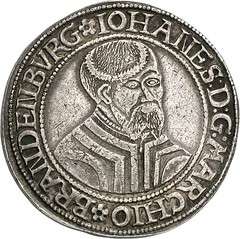

29 Brandenburg-Prussia. John of Küstrin, 1535-1571. Thaler 1545, Krossen. Dav. 8956. Very rare. Very fine to extremely fine. Estimate: 40,000 euros.


143 Hamburg. 1/2 portugalöser of 5 ducats n. y. (1668-1673), Mint master Matthias Freude. Extremely rare. Extremely fine. Estimate: 60,000 euros.


222 Nassau. Frederick Augustus of Usingen, 1803-1816, and Frederick William of Weilburg, 1806-1816. Konventionsthaler n. y. (1815) on the visit in Ehrenbreitstein. Hybrid coin. Extremely rare. Proof strike, about FDC. Estimate: 30,000 euros.

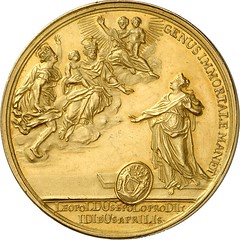
359 HRE. Charles VI, 1711-1740. Gold medallion of 27 ducats 1716 by P. Roettiers on the birth of Archduke Leopold, minted at the behest of Brügge. Kenis 3. Probably 2nd known specimen, only specimen on the market. Extremely fine to FDC. Estimate: 30,000 euros.


416 Denmark. Frederick IV, 1699-1730. 5 ducats 1704, Copenhagen. Fb. 246. Very rare. Extremely fine. Estimate: 75,000 euros.


419 Denmark. Christian VII, 1766-1808. Piaster 1771 (minted in 1774), Copenhagen for the trade with China. Minted by the Danish Asiatic Company following the model of the South American 8 reales piece. Dav. 411. Extremely rare. Extremely fine to FDC. Estimate: 80,000 euros.

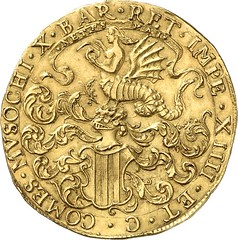
468 Italy / Retegno. Antonio Teodoro Trivulzio, 1676-1678. 10 zecchini 1677, Retegno. Fb. 986. Very rare. Extremely fine. Estimate: 100,000 euros.

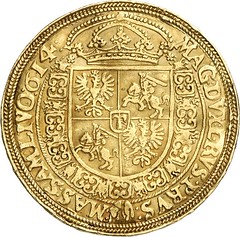
520 Poland. Sigismund III, 1587-1632. 5 ducats 1614, Bromberg. Kopicki 1326. Unique specimen. Very rare. Estimate: 80,000 euros.


586 Hungary. George I Rakoczi, 1630-1648. 10 ducats 1637, Klausenburg. Fb. 375. Extremely rare. Extremely fine. Estimate: 40,000 euros.


598 India. Gold achievement medal by W. Wyon n. y. (awarded in 1853) to William Waterfield for study of Hindi language. Puddester 800.5. Very rare. Extremely fine to FDC. Estimate: 12,500 euros.
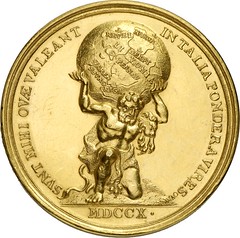

634 Russia. Peter I, 1682-1725. Gold medal of 20 ducats 1710 by P. Stadnitsky on the Russian conquests in 1710. Diakov – (cf. 38.6). Very rare. Extremely fine to FDC. Estimate: 30,000 euros.
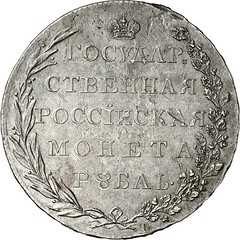

678 Russia. Alexander I, 1801-1825. Test strike of rouble 1801, St. Petersburg (Imperial Bank Mint). Bitkin 627. Extremely rare. Very fine. Estimate: 75,000 euros.


687 Russia. Nicholas I, 1825-1855. 12 rouble Platinum 1837, St. Petersburg. Fb. 158. Mintage only 53 examples. From auction sale Hirsch 22 (1959), 1060. PP, only slightly touched. Estimate: 40,000 euros.
THE BOOK BAZARREWayne Homren, Editor The Numismatic Bibliomania Society is a non-profit organization promoting numismatic literature. See our web site at coinbooks.org. To submit items for publication in The E-Sylum, write to the Editor at this address: whomren@gmail.com To subscribe go to: https://my.binhost.com/lists/listinfo/esylum All Rights Reserved. NBS Home Page Contact the NBS webmaster 
|